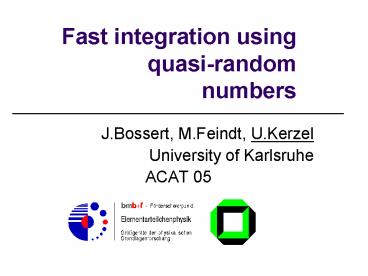Fast integration using quasirandom numbers - PowerPoint PPT Presentation
Title:
Fast integration using quasirandom numbers
Description:
Optimising discrepancy. Minima for N = 2k 'tune' discrepancy by carefully choosing needed N ... Optimising numerical integration ... – PowerPoint PPT presentation
Number of Views:34
Avg rating:3.0/5.0
Title: Fast integration using quasirandom numbers
1
Fast integration usingquasi-randomnumbers
- J.Bossert, M.Feindt, U.Kerzel
- University of Karlsruhe
- ACAT 05
2
Outline
- Numerical integration
- Discrepancy
- The Koksma-Hlawka inequality
- Pseudo- and quasi-random numbers
- Generators for quasi-random numbers
- Optimising the discrepancy
- Quasi-random numbers in n dimensions
- Comparison
- Examples
3
Numerical integration
- Integral evaluation using MC technique
- interprete integral as expectation value
- estimate by averaging over N samples
- use uniformly distributed pseudo-random
numbers - to sample
- define error
4
Discrepancy
- measure of roughness
- (deviation from desired flat distribution)
large discrepancy
small discrepancy
5
Discrepancy cont...
- in 2 dimensions
- local discrepancy
- (number of points in J proportional to ratio of
area of J to unit square) - generalised to s dimensions
N points in unit square
points in J
6
Discrepancy cont...
- Discrepancy of a ensemble P with norm
one corner of J in (0,0) of unit square
7
Koksma-Hlawka inequality
- relates error on numerical integration with
discrepancy - two handles to minimise error ?
- minimise variation of function
- variable transformation
- importance sampling
- sample with numbers with
- low discrepancy
8
Pseudo-random numbers
- follow deterministric pattern
- created by e.g. linear congruence generator
- statistically independent from each other
- simulated real random numbers
- Beware of period of generator (e.g. Ranlux
10165 ) - Discrepancy
9
Lattice
- 1d equidistant points have minimal discrepancy
- first idea extend to s dimensions
- ! lattice
- need Nnd points
- (otherwise no lattice)
10
Quasi-random numbers
- constructed to be evenly distributed
- not independent from each other
- need to know total number N from beginning
- good for integration, not simulation
- low discrepancy series
- faster convergence, smaller error
11
Quasi-random series
- van der Corput series
- other series
- Halton extending Corput series to several
dimensions - Hammersly replace 1st dim. of Halton series by
lattice - ) lower discrepancy
radically inverse function
12
(T,M,S) nets and (T,S) series
- (t,s) series class of quasi-random numbers using
radically inverse functions with low discrepancy - (t,m,s) net each elementary interval E (Vol(E)
bt-m ) contains bt points of series with bm total
points
basis
(2,6,2) net 26 64 total points 22 4 points
in E
elementary interval E
13
Pseudo- vs. Quasi-random
- generate 2048 numbers
pseudo random
quasi random
14
Comparison
lattice
pseudo- random
quasi- random
15
Generator examples
Niederreiter
Faure
Sobol
16
Optimising discrepancy
- Minima for N 2k
- tune discrepancy by carefully choosing needed N
17
several dimensions
- compare discrepancy in several dimensions
- ! quasi-random numbers good in few dimensions
18
Example Breit-Wigner
- numerical integration of multi-dim. BW
- e.g. 2 dimensions
deviation from real integral value (8.8116863
10-1)
19
Optimising numerical integration
- Example convolution of BW with resolution per
event (B0 mixing analysis) - use quasi-random numbers ) fewer numbers N
needed for evaluation - transform for optimal function sampling )
importance-sampling
20
Q-VEGAS
- VEGAS package for numerical integration in
several dimensions - start with uniform intervals
- evaluate function values in these intervals
- iteratively adopt interval structure to shape of
function - Q-VEGAS use quasi-random numbers instead of
pseudo-random numbers - faster and more accurate evaluation
21
Summary
- Low discrepancy (evenly distributed) numbers
important in numerical integration. - Quasi-random numbers superior in few dimensions
- faster convergence
- higher accuracy
- Wide range of applications, e.g. Q-Vegas































